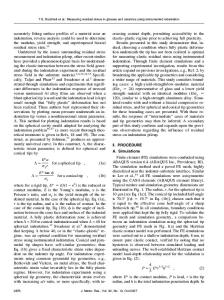Sharp probes of varying acuity: Instrumented indentation and fracture behavior
- PDF / 709,745 Bytes
- 11 Pages / 612 x 792 pts (letter) Page_size
- 43 Downloads / 350 Views
The fracture and instrumented indentation behavior of a range of materials subjected to indentation by four sharp probes varying in acuity from the Berkovich to the cube-corner was studied. Quantities derived from load, displacement, and continuous stiffness measurements were evaluated for their ability to detect “pop-in”—sudden displacement excursions associated with fracture. It was found that gross unloading character was sensitive to the presence of fracture, even when no pop-in was detected. This may be useful in the development of fracture toughness estimation models that do not rely on the imaging of cracks.
I. INTRODUCTION
Much of the instrumented indentation literature, whether experimental or theoretical, has focused on the behavior of the Berkovich indenter. The Berkovich indenter is the three-sided analog to the four-sided Vickers indenter, itself an extremely common mechanical probe. The Vickers indenter has infrequently been used for instrumented indentation, normally only at large scales,1 or as a comparison to the Berkovich.2–4 Also less common in instrumented indentation are spherical (or “Hertzian”) probes. Spherical probes complement sharp probes because a region of purely elastic contact occurs before the onset of yield, allowing the possibility of deducing metallic flow rules from a single contact event.5 Another three-sided pyramidal probe that has garnered interest is the cube-corner indenter. Much more acute than the Berkovich, the cube corner has been utilized as a probe that can dramatically lower the threshold load for indentation fracture.6,7 Hence, the cube-corner has been used as a tool for investigating thin-film toughnesses8,9 or in methods for measuring local surface stresses through the attenuation or enhancement of stable crack lengths.10,11 There has also been a recent spate of interest in estimating plastic flow rules by indentation utilizing more than one sharp probe.12–17 Recently, Field et al.18 suggested the possibility of making fracture toughness estimates using indentation techniques19,20 without imaging the crack lengths. These
a)
Address all correspondence to this author. e-mail: [email protected] b) Present address: Department of Chemical Engineering, Princeton University, Princeton, NJ 08544. J. Mater. Res., Vol. 19, No. 1, Jan 2004
http://journals.cambridge.org
Downloaded: 28 Sep 2015
estimates rest on the phenomena of “pop-in”, in which there is a sudden displacement excursion on loading, associated with fracture at the indentation site. Detection of pop-in has been the subject of some interest in evaluating coating properties.21,22 Here, we present results associated with the acuity of sharp, three-sided, pyramidal mechanical probes, with particular attention to indentation fracture. Four separate probes are used: the Berkovich, cube-corner, and two probes of intermediate acuity. Two metals, two halide salts, and two silicate glasses were chosen to represent a wide range of material behavior. Indentations were imaged after the event by scanning electron m
Data Loading...









